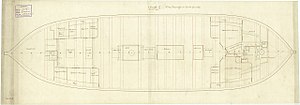HMS Ganges was a 74-gun third-rate ship of the line of the Royal Navy, launched in 1782 at Rotherhithe. She was the first ship of the Navy to bear the name, and was the name ship of her class. She saw active service from 1782 to 1811, in Europe and the West Indies.
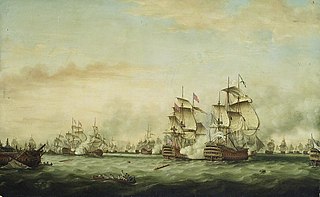
HMS Barfleur was a 90-gun second-rate ship of the line of the Royal Navy, designed by Sir Thomas Slade on the lines of the 100-gun ship Royal William, and launched at Chatham Dockyard on 30 July 1768, at a cost of £49,222. In about 1780, she had another eight guns added to her quarterdeck, making her a 98-gun ship; she possessed a crew of approximately 750. Her design class sisters were the Prince George, Princess Royal, and Formidable. She was a ship of long service and many battles.
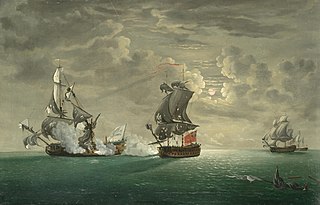
HMS Monmouth was a 66-gun third-rate ship of the line of the Royal Navy, and was likely named for James, Duke of Monmouth. She served from 1667 to 1767, winning ten battle honours over a century of active service. She was rebuilt a total of three times during her career—each time effectively becoming a completely new ship.

HMS Royal George was a 100-gun first rate ship of the line of the Royal Navy, launched from Chatham Dockyard on 16 September 1788. She was designed by Sir Edward Hunt, and Queen Charlotte was the only other ship built to her draught. She was the fifth ship of the Royal Navy to bear the name.

HMS Caledonia was a 120-gun first-rate ship of the line of the Royal Navy, launched on 25 June 1808 at Plymouth. She was Admiral Pellew's flagship in the Mediterranean.
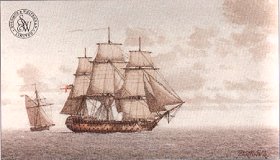
HMS Edgar was a 74-gun third-rate ship of the line of the Royal Navy, that saw service in the American Revolutionary, French Revolutionary and Napoleonic Wars. Launched in 1779, she fought in the battles of Cape St Vincent and Copenhagen, two of the major naval engagements of the wars.

HMS Excellent was a 74-gun third-rate ship of the line of the Royal Navy, launched at Harwich on 27 November 1787. She was the captaincy of John Gell before he was appointed an admiral.
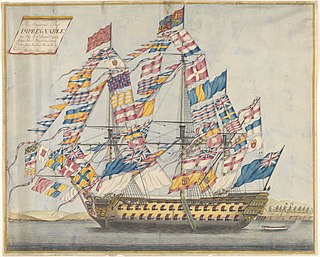
HMS Impregnable was a Royal Navy 98-gun second rate ship of the line launched on 15 April 1786 at Deptford Dockyard. She was wrecked in 1799 off Spithead.

HMS London was a 90-gun second-rate ship of the line of the Royal Navy, launched on 24 May 1766 at Chatham Dockyard.

HMS Alcide, the French and Italian version of "Alcides", another name for Heracles, was a 74-gun third-rate ship of the line of the Royal Navy, designed by Sir Thomas Slade and built by Adam Hayes at Deptford Dockyard being launched on 30 July 1779.
HMS Bedford was a Royal Navy 74-gun third rate. This ship of the line was launched on 27 October 1775 at Woolwich.
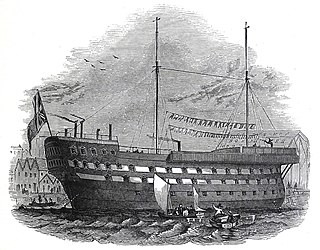
HMS Warrior was a 74-gun Alfred-class third-rate ship of the line of the Royal Navy, launched on 18 October 1781 at Portsmouth.

HMS Calcutta was an 84-gun second-rate ship-of-the-line of the Royal Navy, built in teak to a draught by Sir Robert Seppings and launched on 14 March 1831 in Bombay. She was the only ship ever built to her draught. She carried her complement of smooth-bore, muzzle-loading guns on two gundecks. Her complement was 720 men.

HMS Prince was a 100-gun first rate ship of the line of the Royal Navy, built by Phineas Pett the Younger at Deptford Dockyard and launched in 1670.

HMS Royal Sovereign was a 100-gun first rate ship of the line of the Royal Navy, built at Woolwich Dockyard and launched in July 1701. She had been built using some of the salvageable timbers from the previous Royal Sovereign, which had been destroyed by fire in 1697.

The Foudroyant was an 80-gun ship of the line of the French Navy. She was later captured and served in the Royal Navy as the Third Rate HMS Foudroyant.

HMS Charles was a 96-gun first-rate ship of the line of the Royal Navy, built by Christopher Pett at Deptford Dockyard until his death in March 1668, then completed by Jonas Shish after being launched in the same month. Her name was formally Charles the Second, but she was known simply as Charles, particularly after 1673 when the contemporary Royal Charles was launched.
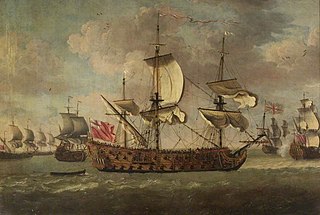
HMS Swiftsure was a 70-gun third-rate ship of the line of the Royal Navy, built by Sir Anthony Deane at Harwich, and launched in 1673. By 1685 she had been reduced to a 66-gun ship.
HMS Torbay was an 80-gun third rate ship of the line of the Royal Navy, launched at Deptford Dockyard on 16 December 1693. In 1707, she served as flagship of Rear-Admiral of the Blue Sir John Norris and belonged to Admiral Sir Cloudesley Shovell's fleet. She saw action during the unsuccessful Battle of Toulon and was present during the great naval disaster off the Isles of Scilly when Shovell and four of his ships were lost, claiming the lives of nearly 2,000 sailors. Torbay suffered little to no damage and finally managed to reach Portsmouth.
HMS Triumph was a 90-gun second rate ship of the line of the Royal Navy, launched at Chatham Dockyard on 2 March 1697. She was renamed HMS Prince in 1714.
